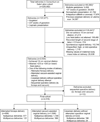Maternal and Neonatal Outcomes by Attempted Mode of Operative Delivery From a Low Station in the Second Stage of Labor
- PMID: 26551186
- PMCID: PMC4683158
- DOI: 10.1097/AOG.0000000000001156
Maternal and Neonatal Outcomes by Attempted Mode of Operative Delivery From a Low Station in the Second Stage of Labor
Abstract
Objective: To evaluate maternal and neonatal outcomes by attempted mode of operative delivery from a low station in the second stage of labor.
Methods: Retrospective study of 2,518 women carrying singleton fetuses at 37 weeks of gestation or greater who underwent attempted forceps-assisted delivery, attempted vacuum-assisted vaginal delivery, or cesarean delivery from a low station in the second stage of labor. Primary outcomes were stratified by parity and included a maternal adverse outcome composite (postpartum hemorrhage, transfusion, endometritis, peripartum hysterectomy, or intensive care unit admission) and a neonatal adverse outcome composite (5-minute Apgar score less than 4, respiratory morbidity, neonatal intensive care unit admission, shoulder dystocia, birth trauma, or sepsis).
Results: In nulliparous patients, the maternal adverse composite was not significantly different between women who underwent attempted forceps (12.1% compared with 10.8%, adjusted odds ratio [OR] 0.77, 95% confidence interval [CI] 0.40-1.34) or vacuum (8.3% compared with 10.8%, adjusted OR 0.68, 95% CI 0.40-1.16) delivery compared with cesarean delivery. Among parous women, the maternal adverse composite was not significantly different with attempted forceps (10.7% compared with 12.5%, adjusted OR 0.40, 95% CI 0.09-1.71) or vacuum (11.3% compared with 12.5%, adjusted OR 0.44, 95% CI 0.11-1.72) compared with cesarean delivery. Compared with neonates delivered by cesarean, the neonatal adverse composite was significantly lower among neonates born to nulliparous women who underwent attempted forceps (9.4% compared with 16.7%, adjusted OR 0.44, 95% CI 0.27-0.72) but not among those who underwent vacuum delivery (11.9% compared with 16.7%, adjusted OR 0.68, 95% CI 0.44-1.04). Among parous women, the neonatal adverse composite was not significantly different after attempted forceps (4.1% compared with 12.5%, adjusted OR 0.28, 95% CI 0.06-1.35) or vacuum (12.5% compared with 12.5%, adjusted OR 1.03, 95% CI 0.28-3.87) compared with cesarean delivery.
Conclusion: A trial of forceps delivery from a low station compared with cesarean delivery was associated with decreased neonatal morbidity among neonates born to nulliparous women.
Level of evidence: II.
Conflict of interest statement
The authors did not report any potential conflicts of interest.
Figures
Similar articles
-
Evaluation of delivery options for second-stage events.Am J Obstet Gynecol. 2016 May;214(5):638.e1-638.e10. doi: 10.1016/j.ajog.2015.11.007. Epub 2015 Nov 18. Am J Obstet Gynecol. 2016. PMID: 26596236 Free PMC article.
-
Maternal and Neonatal Morbidity After Attempted Operative Vaginal Delivery According to Fetal Head Station.Obstet Gynecol. 2015 Sep;126(3):521-529. doi: 10.1097/AOG.0000000000001000. Obstet Gynecol. 2015. PMID: 26244539
-
Severe maternal and neonatal morbidity after attempted operative vaginal delivery.Am J Obstet Gynecol MFM. 2021 May;3(3):100339. doi: 10.1016/j.ajogmf.2021.100339. Epub 2021 Feb 23. Am J Obstet Gynecol MFM. 2021. PMID: 33631384
-
Comparison of Maternal Labor-Related Complications and Neonatal Outcomes Following Elective Induction of Labor at 39 Weeks of Gestation vs Expectant Management: A Systematic Review and Meta-analysis.JAMA Netw Open. 2023 May 1;6(5):e2313162. doi: 10.1001/jamanetworkopen.2023.13162. JAMA Netw Open. 2023. PMID: 37171818 Free PMC article.
-
Ultrasound vs routine care before instrumental vaginal delivery: A systematic review and meta-analysis.Acta Obstet Gynecol Scand. 2021 Nov;100(11):1941-1948. doi: 10.1111/aogs.14236. Epub 2021 Aug 8. Acta Obstet Gynecol Scand. 2021. PMID: 34314520
Cited by
-
Can We Predict Feto-Maternal Adverse Outcomes of Vacuum Extraction?Geburtshilfe Frauenheilkd. 2022 Sep 7;82(11):1274-1282. doi: 10.1055/a-1904-6025. eCollection 2022 Nov. Geburtshilfe Frauenheilkd. 2022. PMID: 36339635 Free PMC article.
-
A Quality Improvement Project Utilizing a Clinical Practice Guideline in Women During Second-Stage Labor.J Perinat Educ. 2020 Apr 1;29(2):72-82. doi: 10.1891/J-PE-D-19-00014. J Perinat Educ. 2020. PMID: 32308356 Free PMC article.
-
Long-term neurodevelopmental outcome in children born after vacuum-assisted delivery compared with second-stage caesarean delivery and spontaneous vaginal delivery: a cohort study.BMJ Paediatr Open. 2023 Oct;7(1):e002048. doi: 10.1136/bmjpo-2023-002048. BMJ Paediatr Open. 2023. PMID: 37848264 Free PMC article.
-
Association of white blood cell count after operative vaginal delivery with maternal adverse outcome: A retrospective cohort study.Ann Clin Epidemiol. 2023 Jul 13;5(4):113-120. doi: 10.37737/ace.23015. eCollection 2023. Ann Clin Epidemiol. 2023. PMID: 38504951 Free PMC article.
-
Maternal and neonatal trauma during forceps and vacuum delivery must not be overlooked.BMJ. 2023 Oct 19;383:e073991. doi: 10.1136/bmj-2022-073991. BMJ. 2023. PMID: 37857419 Free PMC article.
References
-
- Martin JA, Hamilton BE, Osterman MJ, Curtin SC, Matthews TJ. Births: final data for 2013. Natl Vital Stat Rep. 2015 Jan 15;64(1):1–68. - PubMed
-
- Obstetric care consensus no 1: safe prevention of the primary cesarean delivery. American College of Obstetricians and Gynecologists; Society for Maternal-Fetal Medicine. Obstet Gynecol. 2014 Mar;123(3):693–711. - PubMed
Publication types
MeSH terms
Grants and funding
LinkOut - more resources
Full Text Sources
Medical
Research Materials


